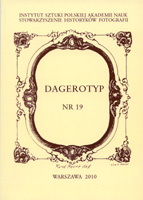Artykuł Józefa Feliksa Zielińskiego „O dagerotypie” i polscy dagerotypiści we Francji
Józef Feliks Zieliński’s Article ‘On the Daguerreotype’ and Polish Daguerreotypists in France
Author(s): Małgorzata Maria GrąbczewskaSubject(s): Photography
Published by: Instytut Sztuki Polskiej Akademii Nauk
Keywords: photography; Polish photography; vintage photography; history of photography; old photographic technique; daguerreotype; Paris; commercial photography; Polish emigracy; Zieliński; Józef Feliks; early photographic publications
Summary/Abstract: This text is an analysis of and a commentary on an article by Józef Feliks Zieliński. The article was written at the end of April 1843, and printed in 1844 in a Polish magazine published in Paris, entitled Pamiętnik Towarzystwa Przyjaciół Przemysłu... (Journal of the Society of Friends of Industry...). Following the Polish November Uprising against Russia in 1831, Józef Feliks Zieliński (1808-1878) became a political émigré. Among the many jobs that he undertook in France, he also became a daguerreotypist. He was the only Polish émigré of his generation to make daguerreotyping his profession, and he made a living out of it for some time. From then on photography was his life-long passion. He learned daguerreotyping in the summer of 1842 in the renowned Parisian studio of Pierre Ambroise Richebourg. From April 1843 until 1848 he ran, together with another émigré, Stanisław Garbowski, his own travelling daguerreotyping studio, under the name “Mr. Felix”, a firm based in Nantes. We know of two daguerreotypes from this studio. Later his associate continued to be active in Nantes at least until the early 1870s. Although Zieliński knew when writing his article that daguerreotype portraits had been made in Poland for already a year, he wanted, nevertheless, to share his knowledge and experience with his compatriots. The article is both of the nature of a historical lecture and a practical handbook. It not only talks about daguerreotyping, but also – though to a lesser extent – about talbotype (calotype), various experimental techniques involving photography on paper, as well as about attempts at making multiple copies of daguerreotypes by means of galvanism. Naturally, it is mainly based on the technical literature available in those days, but it also contains Zieliński’s own observations regarding, for example, equipment – daguerreotype cameras, lenses, etc., and lists the best optical firms with information about prices, as well as mentioning the method of colouring daguerreotypes that was designed by Zieliński. It also contains a somewhat awkward attempt at introducing photographic and photochemical terminology into the Polish language. The author quoted the whole of Zieliński’s article and provided 86 footnotes. She also gathered some information on other Polish daguerreotypists in France, of whom very little is known as no-one has undertaken any research on this subject to date. These are: Feliks Bliziński, Seweryn Cichowski, Jan Henryk Humnicki (whose one daguerreotype the author managed to find), Napoleon Orda, Antoni Strusiński, Teofil Strzelecki and Michał Szweycer. M.M. Grąbczewska’s text signals the publication of a larger work devoted to Józef Feliks Zieliński’s photographic activity.
Journal: Dagerotyp
- Issue Year: 2010
- Issue No: 19
- Page Range: 4-55
- Page Count: 52
- Language: Polish
- Content File-PDF

